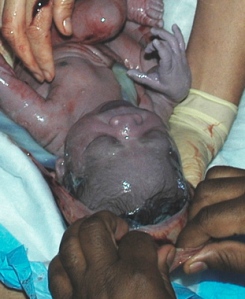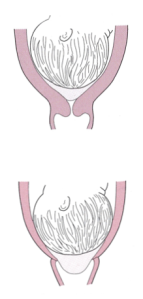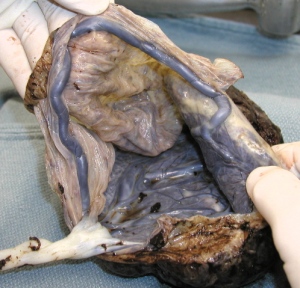 Artificial rupture of membranes (ARM) aka ‘breaking the waters’ is a common intervention during birth. However, an ARM should not be carried out without a good understanding of how the amniotic sac and fluid function in labour. Women need to be fully informed of the risks associated this intervention before agreeing to alter their labour in this way. This post will discuss how the ‘waters’ work in labour and the implications of breaking them.
Artificial rupture of membranes (ARM) aka ‘breaking the waters’ is a common intervention during birth. However, an ARM should not be carried out without a good understanding of how the amniotic sac and fluid function in labour. Women need to be fully informed of the risks associated this intervention before agreeing to alter their labour in this way. This post will discuss how the ‘waters’ work in labour and the implications of breaking them.Anatomy and physiology
By the end of pregnancy the baby is surrounded by around 500-1000mls of Fluid. This is mostly made up of amniotic fluid secreted by the amniotic sac (the membranes). The baby also contributes urine and respiratory tract secretions into the fluid. The amniotic fluid is constantly being produced and renewed – Baby swallows the fluid; it is passed through the gut into the baby’s circulation; then sent out through the placenta. This process continues even if the amniotic membranes have broken. So, even when the waters have ‘gone’ there is still some fluid present ie. there is no such thing as a ‘dry labour’.
The amniotic membrane is adhered to the chorion – another membrane between the amniotic membrane and the uterus. These membranes look like one, but you can tease them apart after birth.
During pregnancy
The amniotic sac protects and prepares baby by:
- Cushioning any bumps to the abdomen.
- Maintaining a constant temperature.
- Allowing movement to aid muscle development.
- Creating space for growth.
- Protecting against infection – the membranes provide a barrier + the fluid contains antimicrobial peptides.
- Assisting lung development – baby breathes fluid in and out of the lungs.
- Taste and smell – the smell of amniotic fluid has been found to have a calming effect on newborns (Varendia et al. 1998).
After 40 weeks gestation around 20% of baby’s will pass meconium into their amniotic fluid as the bowels reach maturity and begin to work. This is perfectly normal and is not a sign of distress. This meconium is diluted and processed with the amniotic fluid as described above.
During labour
Around 80-90% of women start their labour with their membranes intact. This is probably because the amniotic sac plays an important role in the physiology of a natural birth.
General fluid pressure
 During a contraction the pressure is equalised throughout the fluid rather than directly squeezing the baby, placenta and umbilical cord. This protects the baby and his/her oxygen supply from the effects of the powerful uterine contractions. When the membranes have ruptured the placenta and baby get compressed during a contraction. Most babies can cope well with this, but the experience of birth for the baby is probably not as pleasant. When the placenta is compressed blood circulation is interrupted reducing the oxygen supply to baby. In addition, the umbilical cord may be in a position where it gets squashed between baby and uterus with contractions. When this happens the baby’s heart rate will dip during a contraction in response to the reduced blood flow. A healthy baby can cope with this intermittent reduction in oxygen supply for hours (it’s a bit like holding your breath for 30 seconds every few minutes). However, this is probably not so great to do for an extended period of time.
During a contraction the pressure is equalised throughout the fluid rather than directly squeezing the baby, placenta and umbilical cord. This protects the baby and his/her oxygen supply from the effects of the powerful uterine contractions. When the membranes have ruptured the placenta and baby get compressed during a contraction. Most babies can cope well with this, but the experience of birth for the baby is probably not as pleasant. When the placenta is compressed blood circulation is interrupted reducing the oxygen supply to baby. In addition, the umbilical cord may be in a position where it gets squashed between baby and uterus with contractions. When this happens the baby’s heart rate will dip during a contraction in response to the reduced blood flow. A healthy baby can cope with this intermittent reduction in oxygen supply for hours (it’s a bit like holding your breath for 30 seconds every few minutes). However, this is probably not so great to do for an extended period of time.Forewaters
The sac of amniotic fluid is describes as having two sections – the forewaters (in front of baby’s head) and the hind waters (behind baby’s head). A ‘hind water leak’ refers to a tear in the the amniotic membranes behind the baby’s head. Often this is experienced by the woman as an occasional light trickle as the fluid has to run down the outside of the sac and past baby’s head to get out.
 During labour forewaters are formed as the lower segment of the uterus stretches and the chorion (the external membrane) detaches from it. The well flexed baby’s head fits into the cervix and cuts off the fluid in front of the head from the fluid behind (hind waters). Pressure from contractions cause the forewaters to bulge downwards into the dilating cervix and eventually through into the vagina. This protects the forewaters from the high pressure applied to the hind waters during a contraction and keeps the membranes intact. The forewaters transmit pressure evenly over the cervix which aids further dilatation. When the baby is in an OP position the head may not flex as well to block off the hind waters = pressure is able to move into the forewaters and they may rupture. Early rupture of membranes if often a feature of an OP labour.
During labour forewaters are formed as the lower segment of the uterus stretches and the chorion (the external membrane) detaches from it. The well flexed baby’s head fits into the cervix and cuts off the fluid in front of the head from the fluid behind (hind waters). Pressure from contractions cause the forewaters to bulge downwards into the dilating cervix and eventually through into the vagina. This protects the forewaters from the high pressure applied to the hind waters during a contraction and keeps the membranes intact. The forewaters transmit pressure evenly over the cervix which aids further dilatation. When the baby is in an OP position the head may not flex as well to block off the hind waters = pressure is able to move into the forewaters and they may rupture. Early rupture of membranes if often a feature of an OP labour.Lubrication
The forewaters usually break when the cervix is almost fully open and the membranes are bulging so far into the vagina that they burst. This ‘fluid burst’ lubricates the vaginal and perineum to facilitate movement of the baby and stretching of the tissues.
Born in the caul
If is fairly common for a baby to be born in the amniotic sac when labour is left to unfold without interference. I have some beautiful photos of this but don’t have permission from the parents to share them online – so if you want to see them you will have to come and study midwifery at USC. However, I have found: Some photos of a waterbirth in the caulon Pamela Hines blog; photos of a land birth in the caul on Navelgazing Midwife’s blog; and a youtube movie:
Although in the movie the midwife breaks the membranes this is not necessary. Eventually the force of the contraction and the movement of the baby will rupture the sac as the baby’s body is born. This can be rather dramatic and messy and is another good reason for the midwife not to be fiddling about at the perineum during birth. A waterbirth in the caul is possibly one of the most amazing sights in the world (and less messy than on land). Once the baby is born the membranes can be peeled off – see the photo at the top of this post.
Historically being born in the caul was considered good luck for the baby. It was also believed that a baby who was born in the caul would be protected from drowning. Midwives used to dry out amniotic membranes and sell them to sailors as a talisman to protect them from drowning. Very enterprising!
Artificial rupture of membranes (ARM) aka amniotomy
 Breaking the membranes with an amni-hook is a common intervention during labour. It is the first step in the induction process (see previous post), and also done in an attempt to speed up spontaneous labour. In an induced labour, intact membranes prevent the artificially created contractions from getting into an effective pattern. There is also the theoretical risk of an induced contraction (that is too strong) forcing amniotic fluid through the membranes/placenta and into the blood system causing an amniotic embolism and maternal death. So an ARM is necessary before a syntocinon/pitocin infusion is started.
Breaking the membranes with an amni-hook is a common intervention during labour. It is the first step in the induction process (see previous post), and also done in an attempt to speed up spontaneous labour. In an induced labour, intact membranes prevent the artificially created contractions from getting into an effective pattern. There is also the theoretical risk of an induced contraction (that is too strong) forcing amniotic fluid through the membranes/placenta and into the blood system causing an amniotic embolism and maternal death. So an ARM is necessary before a syntocinon/pitocin infusion is started.In a spontaneous labour the rationale for an ARM is that once the forewaters have gone the hard baby’s head will apply direct pressure to the cervix and open it quicker. However, a cochrane review of the available research states that “the evidence showed no shortening of the length of first stage of labour and a possible increase in caesarean section. Routine amniotomy is not recommended for normally progressing labours or in labours which have become prolonged.”
There are also risks associated with an ARM:
- It may increase contraction intensity and pain which can result in the woman feeling unable to cope and choosing an epidural… intervention rollercoaster begins.
- The baby may become distressed due to compression of the placenta, baby and/or cord (as described above).
- The umbilical cord may be swept down by the waters and either past the baby’s head or wedged next to the baby’s head. This is called a ‘cord prolapse’ and is an emergency situation. The compression of the cord interrupts or stops the supply of oxygen to the baby and the baby must be born asap by c-section. The only cord prolapse I have been involved with happened after an ARM (not done by me - honest!). The outcome for the woman was a live baby born by emergency c-section. Her previous 2 babies had been vaginal births.
- If there is a blood vessel running through the membranes (see picture below) and the amni-hook ruptures the vessel the baby will lose blood volume fast – another emergency situation.
- There is a slight increase in the risk of infection but mostly for the mother (not baby). This risk is minimal if nothing is put into the vagina during labour (ie. hands, instruments etc.).
Summary
The amniotic sac and fluid play an important role in facilitating birth and protecting the baby. There is no evidence that rupturing this sac will reduce the length of labour. While every intervention has it’s place including ARM, midwives need to carefully consider the risks before offering it to women. Also women must be fully informed of the risks before choosing an ARM during their labour.




No comments:
Post a Comment